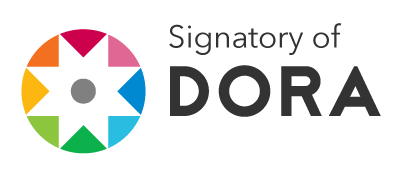A Facile Approach toward 8-O-4'-Neolignans: Synthesis of Threo-7',8'-Dihydromachilin D through Jacobsen Epoxidation
Resumen
Neolignans are natural phenylpropanoid dimers with C-O-C linkages. Currently, neolignans remain as important synthetic targets due to their reported biological potential against parasites and fungal infections. Thereof, a new approach for the synthesis of the 8-O-4'-neolignan 7',8'-dihydromachilin D based on Jacobsen epoxidation as key step is described here. This stereoselective synthesis proceeded in only 4 steps in 3.9% overall yield. Jacobsen epoxidation was firstly optimized regarding to yield and enantioselectivity employing trans-stilbene as model substrate.
Descargas
Lenguajes:
enAgencias de apoyo:
Universidad Nacional de ColombiaReferencias bibliográficas
• Aveniente M., Pinto E.F., Santos L.S., Rossi- Bergmann B., Barata L.E.S. 2007. Structure–activity relationship of antileishmanial neolignan analogues. Bioorganic & Medicinal Chemistry, 15:7337-7343.
• Bahramian B., Mirkhani V., Tangestaninejad S., Moghadamb M. 2006. Catalytic epoxidation of olefins and hydroxylation of alkanes with sodium periodate by water-soluble manganese(III) salen. Journal of Molecular Catalysis A: Chemical, 244:139-145.
• Barata L.E.S., Baker P.M., Gottlieb O.R., Rúveda E.A. 1978. Neolignans of Virola surinamensis. Phytochemistry, 17:783-786.
• Barrero A.F., Alvarez-Manzanedaan E.J., Chahboun R. 1998. Synthesis of Wiedendiol-A and Wiedendiol-B from labdane diterpenes. Tetrahedron, 54:5635-5650.
• Baudequin C., Baudoux J., Levillain J., Cahard D., Gaumont A.C., Plaquevent J.C. 2003. Ionic liquids and chirality: opportunities and challenges. Tetrahedron: Asymmetry, 14:3081-3093.
• Bernal F.A. and Cuca Suárez L.E. 2009. Chemical constituents from Iryanthera ulei Warb. Bio-chemical Systematics and Ecology, 37:772-775.
• Buchi G., Foulkes D.M., Kurono M., Mitchell G.F., Schneider R.S. 1967. The total synthesis of racemic Aflatoxin B1. Journal of the American Chemical Society, 89:6745-6753.
• Cavallo L. and Jacobsen H. 2003. Electronic effects in (salen)Mn-based epoxidations catalysts. Journal of Organic Chemistry, 68:6202-6207.
• Chang H-T. and Sharpless K.B. 1996. Molar scale synthesis of enantiopure stilbene oxide. Journal of Organic Chemistry, 61:6456-6457.
• Clarke E.F., McGarrigle E.M., Gilheany D.G. 2005. Cr-Salen mediated asymmetric epoxidation of alkenes: rational complex design and substrate scope of catalyst. ARKIVOC, I:30-38.
• Durand J., Teuma E., Gómez M. 2007. Ionic liquids as a medium for enantioselective catalysis. Comptes Rendus Chimie, 10:152-177.
• Gu W.X., Chen X.C., Pan X.F., Chan A.B.S., Yang T-K. 2000. First enantioselective syntheses of (2R,3R)- and (2S,3S)-3-(4-hydroxy- 3-methoxyphenyl)-2-hydroxymethyl-1,4- benzodioxan-6-carbaldehyde. Tetrahedron: Asymmetry, 11:2801-2807.
• Gupta K.C. and Sutar A.K. 2008. Catalytic activities of Schiff base transition metal complexes; Coordination Chemistry Reviews, 252:1420-1450.
• Hada S., Hattori M., Tezuka Y., Kikuchi T., Namba T. 1988. New neolignans and lignans from the aril of Myristica fragrans. Phytochemistry, 27:563-568.
• Herrera A.C., Zacchino S., Badano H., González M., Rúveda E.A. 1984. 13C NMR spectral and conformational analysis of 8-O-4' neolignans. Phytochemistry, 23:2025-2028.
• Imuta M. and Ziffer H. 1979. Synthesis and physical properties of a series of optically active substituted trans-stilbene oxides. Journal of Organic Chemistry, 44:2505-2509.
• Jacobsen E.N. 2000. Asymmetric catalysis of epoxide ring-opening reactions. Accounts of Chemical Research, 33:421-431.
• Jacobsen E.N., Zhang W., Muci A.R., Ecker J.R., Den L. 1991. Highly enantioselective epoxidation catalysts derived from 1,2-diaminocyclohexane. Journal of the American Chemical Society, 113:7063-7064.
• Jorapur Y.R.and Chi D.Y. 2006. Ionic liquids: an environmentally friendly media for nucleophilic substitution reactions. Bulletin of the Korean Chemical Society, 27:345-354.
• Khavrutskii I.V., Musaev D.G., Morokuma K. 2004. Epoxidation of unfunctionalized olefins by Mn(salen) catalyst using organic peracids as oxygen source: A theoretical study. Proceedings of the National Academic of Sciences, 101:5743-5748.
• Kumar A. 2007. Epoxidation of alkenes with hydrogen peroxide catalyzed by 1-methyl-3-bu-tylimidazoliumdecatungstate in ionic liquid. Catalysis Communications, 8:913-916.
• Liao S. and List B. 2009. Asymmetric Counteranion-Directed Transition-Metal Catalysis: Enantioselective Epoxidation of Alkenes with Manganese(III) Salen Phosphate Complexes. Angewandte Chemie International Edition, 48:1-5.
• Llàcer E., Romea P., Urpí F. 2006. Studies on the hydrogenolysis of benzyl ethers. Tetrahedron Letters, 47:5815-5818.
• McGarrigle E.M., Gilheany D.G. 2005. Chromium and manganese salen promoted epoxidation of alkenes. Chemical Reviews, 105:1563-1602.
• Miessler G.L. and Tarr D.A. 2004. Inorganic Chemistry. Third Edition. Pearson Education South Asia Pte Ltd., Jurong, Singapore. 697p.
• Nocito I., Castelli M.V., Zacchino S.A., Serra E. 2007. Activity of 8.O.4´-neolignans against Trypanosoma cruzi. Parasitology Research, 101:1453-1457.
• Ollevier T. and Lavie-Compin G. 2004. Bismuth triflate-catalyzed mild and efficient epoxide opening by aromatic amines under aqueous conditions. Tetrahedron Letters, 45:49-52.
• Pârvulescu V.I., Hardacre C. 2007. Catalysis in ionic liquids. Chemical Reviews, 107:2615-2665.
• Pastor I.M. and Yus M. 2005. Asymmetric ring opening of epoxides. Current Organic Chemistry, 9:1-29.
• Phan M.G., Phan T.S., Matsunami K., Otsuka H. 2006. New neolignans and lignans from Viet-namese medicinal plant Machilus odoratissima Nees. Chemical & Pharmaceutical Bulletin, 54:380-383.
• Pinheiro A.A.C., Borges R.S., Santos L.S., Alves C.N. 2004. A QSAR study of 8.O.4-neolignans with antifungal activity. Journal of Molecular Structure: THEOCHEM, 672:215-219.
• Pinto L.D., Dupont J., de Souza R.F., Bernardo- Gusmão K. 2008. Catalytic asymmetric epoxidation of limonene using manganese Schiff-base complexes immobilized in ionic liquids. Catalysis Communications, 9:135-139.
• Pond F.J. and Beers F.T. 1897. Derivatives of eugenol. Journal of the American Chemical Society, 19:825-831.
• Reddy P.R. and Das B. 2014. The first stereoselective total synthesis of a new antitumour and anti-inflammatory neolignan, surinamensinol A. RSC Advances, 4:7432-7434.
• Sadhu S.K., Okuyama E., Fujimoto H., Ishibashi M. 2003. Separation of Leucas aspera, a medicinal plant of Bangladesh, guided by prostaglandin inhibitory and antioxidant activities. Chemical and Pharmaceutical Bulletin, 51:595-598.
• Sefkow M. 2003. The stereoselective synthesis of neolignans. Synthesis, 17:2595-2625.
• Shimomura H., Sashida Y., Oohara M. 1987. Lignans from Machilus thunbergii. Phytochemistry, 26:1513-1515.
• Skarżewski J., Gupta A., Vogt A. 1995. Influence of additional ligands on the two-phase epoxidation with sodium hypochlorite catalyzed by (salen) manganese (III) complexes. Journal of Molecular Catalysis A: Chemical, 103:L63-L68.
• Solladié-Cavallo A., Bouérat L., Roje M. 2000. Asymmetric synthesis of trans-disubstituted aryl-vinyl epoxides: a p-methoxy effect. Tetrahedron Letters, 41:7309-7312.
• Song C.E., Roh E.J. 2000. Practical method to recycle a chiral (salen)Mn epoxidation catalyst by using an ionic liquid. Chemical Communications, 837-838.
• Song C.E., Yoon M.Y., Choi D.S. 2005. Significant improvement of catalytic efficiencies in ionic liquids. Bulletin of the Korean Chemical Society, 26:1321-1330.
• Tang X., Tang Y., Xu G., Wei S., Sun Y. 2008. Highly enantioselective epoxidation of styrene and α-methylstyrene catalyzed by new doubly-immobilized chiral (salen)Mn(III) catalysts. Catalysis Communications, 10:317-320.
• Tian H., She X., Yu H., Shu L., Shi Y. 2002. Designing new chiral ketone catalysts. Asymmetric epoxidation of cis-olefins and terminal olefins. Journal of Organic Chemistry, 67:2435-2446.
• Tsai I-L., Hsleh C-F., Duh C-Y., Chen I-S. 1996. Cytotoxic neolignans from Persea obovatifolia. Phytochemistry, 43:1261-1263.
• Wasserscheid P. and Welton T. (ed). 2008. Ionic Liquids in Synthesis. 2nd edition. WILEY-VCH Verlag GmbH & Co. KGaA, Weinheim, 721p.
• Welton T. 2004. Ionic liquids in catalysis. Coordination Chemistry Reviews, 248:2459-2477.
• Wheeler C., West K.N., Liotta C.L., Eckert C.A. 2001. Ionic liquids as catalytic green solvents for nucleophilic displacement reactions. Chemical Communications, 887-888.
• Xia Y., Chang L., Ding Y., Jiao B. 2010. Asymmetric synthesis of erythro-8-O-4'-neolignan Machilin C. Mendeleev Communications, 20:151-152.
• Xia Y-M., Wang W. 2011. Asymmetric synthesis of the natural erythro-(1R,2S)-8-O-4'-neolignan myrislignan. Monatshefte für Chemie, 142:93-96.
• Xia Y-M., Wang W., Guo Y-L., Li J-F. 2010. Asymmetric synthesis of 8-O-4'-neolignan perseal B. Turkish Journal of Chemistry, 34:375-380.
• Zhang W. and Jacobsen E.N. 1991. Asymmetric olefin epoxidation with sodium hypochlorite catalyzed by easily prepared chiral Mn(III) salen complexes. Journal of Organic Chemistry, 56:2296-2298.
• Zhang W., Loebach J.L., Wilson S.R., Jacobsen E.N. 1990. Enantioselective epoxidation of un-functionalized olefins catalyzed by (Salen)Manganese complexes. Journal of the American Chemical Society, 112:2801-2803.
• Zhao D., Wu M., Kou Y., Min E. 2002. Ionic liquids: applications in catalysis. Catalysis Today, 74:157-189.
• Zheng X.M., Qi Y.X., Zhang X.M., Suo J.S. 2004. Chiral Salen Manganese complex immobilized on SBA-15: A new heterogenized enantioselective catalyst for the epoxidation of alkenes. Chinese Chemical Letters, 15:655-658.












